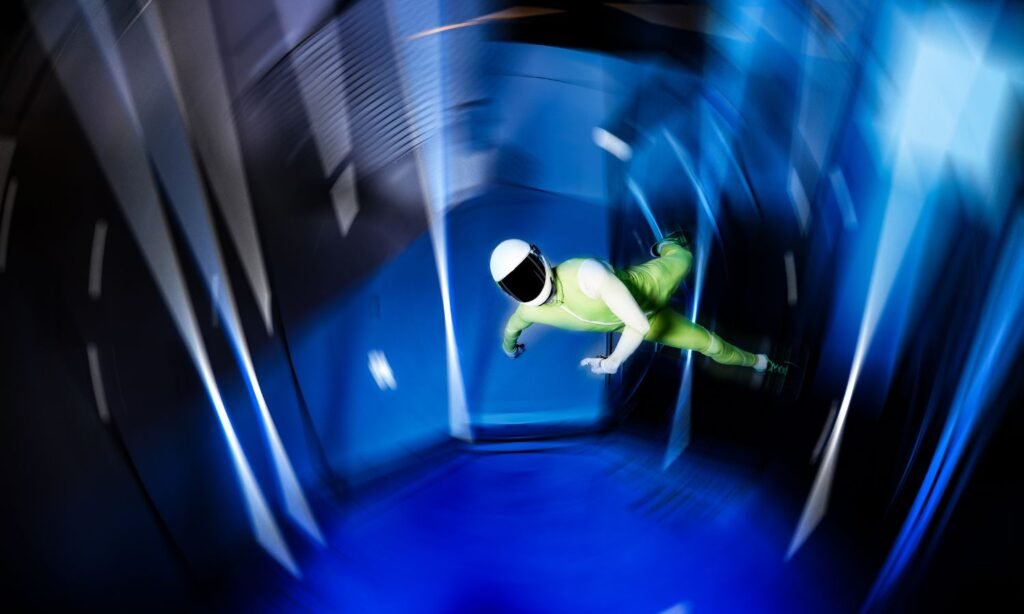As thrilling as indoor skydiving may be, the burning question remains: does this adrenaline-pumping activity truly burn calories? A delve into the world of wind tunnel skydiving unveils both the physical demands and the potential fitness benefits that accompany this exhilarating pursuit.
Develop strength and endurance
Indoor skydiving isn’t just about defying gravity; it demands physical prowess. The sheer force of the wind against the body challenges core stability, arm strength, and leg endurance.
It’s akin to holding a plank while being propelled upwards by a gust of air, requiring engaged muscles to maintain balance and form.
Boost your indoor skydiving experience with supportive exercises
For those eyeing indoor parachuting as a fitness regimen, complementing it with specific exercises amplifies its impact. Strengthening the core through planks, leg lifts, and stability exercises fortifies the body for the demands of wind tunnel skydiving.
Get flexy and tune up your core
Flexibility is key. The aerodynamics of indoor skydiving necessitate a level of agility and suppleness. Yoga, stretching, and Pilates can aid in enhancing flexibility, and promoting better movement control within the wind tunnel.
Feel the burn
The intensity of wind tunnel skydiving triggers a metabolic surge. Studies suggest that high-intensity interval training (HIIT) activities, similar to the bursts of energy required in indoor skydiving, promote calorie burn long after the activity ceases. “Indoor skydiving for an hour will burn around 700 calories”- In-text citation: (Find Out Our Latest News on the Into The Blue Blog, 2022)
Does indoor skydiving make you tired?
Indoor skydiving is a physically demanding activity that rivals many sports in intensity. Unlike traditional skydiving, it occurs in a controlled wind tunnel environment. Participants navigate and manipulate their bodies against the updraft, demanding core strength, balance, and agility. The dynamic nature of indoor skydiving requires precise coordination and spatial awareness.
The blend of physical exertion and adrenaline rush can leave participants feeling both exhilarated and fatigued.
While not exhaustive, indoor skydiving can induce a level of fatigue comparable to moderate physical exercise. In essence, it goes beyond the misconception of simply ‘falling’ indoors, representing a captivating fusion of athleticism and aerodynamics. Indoor skydiving offers an exciting venture that challenges both mind and body, providing a comprehensive workout for thrill-seekers and fitness enthusiasts alike.
How many calories does indoor skydiving burn?
Quantifying the exact caloric expenditure during indoor skydiving is quite tricky due to various influencing factors such as body weight, flight duration, and individual effort levels.
Estimates suggest that a 30-minute session could range from torching 300 to 600 calories, resembling the burn of a moderate-intensity workout. Moreover, incorporating skill level and the intensity of maneuvers performed during indoor skydiving adds further complexity to caloric estimations, making it a dynamic and engaging form of exercise.
According to anecdotal reports, a one-hour session is commonly believed to result in burning around 700 calories, emphasizing the potential for this activity to offer a substantial calorie-burning workout.
Unpacking the myths
Contrary to popular belief, indoor skydiving isn’t exclusively for the physically fit. Individuals across various fitness levels can engage in this activity. The experience can be tailored to suit different needs, making it accessible to a broader spectrum of enthusiasts.
The final verdict
While indoor skydiving may not be a one-stop solution for weight loss, its blend of physical challenges and adrenaline rush makes it a compelling choice for those seeking an engaging workout. Combining it with a balanced exercise regimen and a healthy lifestyle enhances its fitness benefits.
In conclusion, indoor skydiving emerges not just as an adrenaline-charged escapade but also as a potential avenue for fitness enthusiasts. Its ability to engage multiple muscle groups, elevate heart rate, and induce a metabolic surge showcases its promising potential as a calorie-burning activity. Despite the lack of precise caloric metrics, its undeniable physical
demands make it a standout choice for those seeking an unconventional yet invigorating fitness experience.
By merging the thrill of defying gravity with the pursuit of fitness, indoor skydiving tantalizes as an enticing gateway to a unique, body-engaging exercise regimen.
Sources:
- Find Out Our Latest News on the Into The Blue Blog. (2022). What is indoor skydiving? A guide to free-fall indoors! [online] Available at: https://www.intotheblue.co.uk/blog/keep-calm-and-go-indoor-skydiving/.

